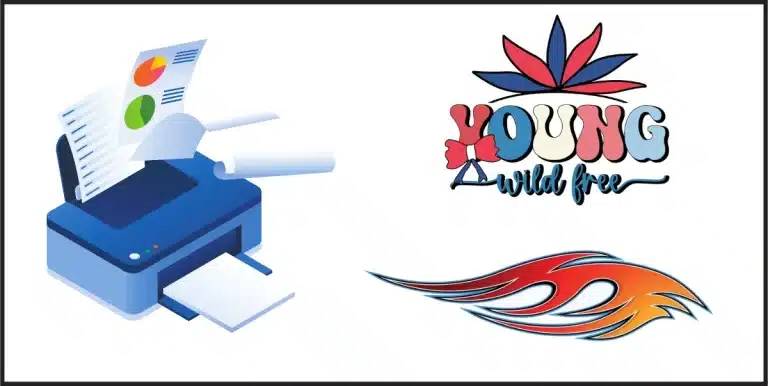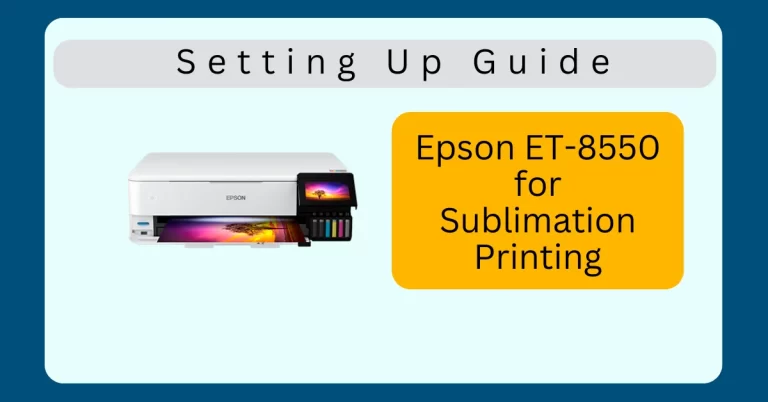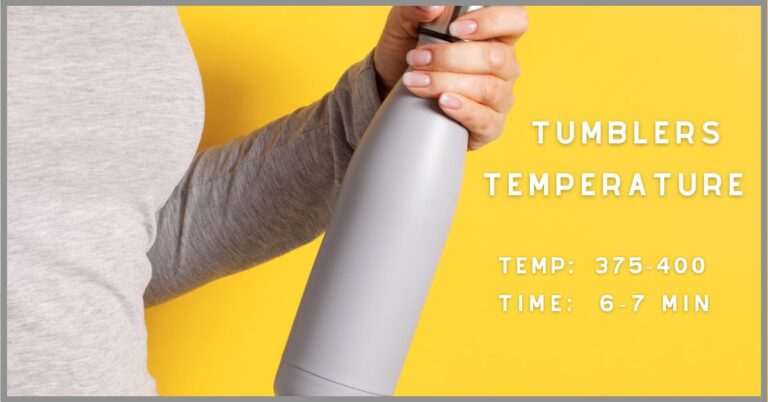DTF vs Sublimation Printing: Hacks, Tips, Differences, Dark Shirts, Materials
Confused about DTF vs sublimation printing? Learn the key differences, how to print on dark shirts, and what materials like powder and transfer film work best.
Explore strategies for using your printer, discover if paper or ink is compatible, and learn about UV printing. Get practical advice to simplify your printing process and achieve exceptional results.
Which Method is Right for You?
The decision between direct thermal transfer (DTF) and sublimation printing comes down to your specific goals, materials, and budget. Both methods have their own advantages that cater to specific needs.

DTF printing requires a higher initial investment and a more complex process. It’s working with fabrics such as cotton, polyester blends, and even non-fabric items. Its ability to produce bright colors on dark surfaces makes it ideal for custom T-shirts, hats, and small to medium-sized orders.

Sublimation printing produces high-quality, durable prints with a soft finish. Sublimation is the most affordable option for beginners or businesses targeting light-colored materials who want permanent, vibrant designs, especially if they focus on polyester fabrics or coated items and want permanent, vibrant designs.
Analyze the advantages and disadvantages of every method, taking into account the fabrics you will employ, the desired print resilience, and your long-term production objectives. The right decision will depend on your needs whether you’re customizing small batches or scaling up for larger projects.
The choice between direct to fabric (DTF) and direct to garment (DTO) is essential for creating prints that are both eye-catching and professional-grade.
Understanding DTF and Sublimation Printing
DTF (Direct-to-Film) and sublimation printing methods are both popular ways to create unique designs on a range of items. The right method’s selection is based on factors such as cost, print quality, and durability.
DTF is known for its vibrant colors on dark fabrics, while sublimation provides softer, long-lasting designs on lighter materials.
By understanding the differences between these methods, you can identify the best fit for your needs and budget.
What is DTF Printing?
Direct-to-Film (DTF) printing is a new way to transfer designs onto different materials. The process of printing a design onto a special film, which is then transferred to the surface of the fabric or material using heat, is not typical of traditional printing techniques.
The fact that it can work on fabrics, like cotton, polyester, blends, and even leather, distinguishes it from other methods.
How Does DTF Printing Work?
The steps of the DTF process:
- Design Creation
Start with a design created in graphic design software. Precision in your artwork is crucial for high-quality results. - Printing
Using a DTF printer loaded with water-based inks, print the design onto a PET film. This film is specially coated to hold the ink for later transfer. - Powder Application
A hot-melt adhesive powder is applied to the printed film. This powder sticks to the wet ink, forming the bond needed for transferring the design. - Curing
Cure the powder by either passing the film through a curing oven or placing it under a heat press. This step creates a solid layer that ensures the print adheres securely. - Transfer
Position the cured film onto the fabric, then use a heat press to transfer the design. The combination of heat and pressure ensures the print bonds well. - Cooling and Peeling
Allow the material to cool slightly, then peel off the film carefully, leaving behind the finished design.

What Do You Need for DTF Printing?
To begin, you will require:
- DTF Printer: A specialized printer designed for this process, typically using water-based inks.
- PET Film: A coated transfer film to hold the printed design.
- Hot-Melt Adhesive Powder: This powder ensures the ink adheres firmly during the transfer.
- Heat Press: A heat press is essential for curing the powder and transferring the design onto the material.
What is Sublimation Printing?
Sublimation printing is used to create prints that are vibrant and durable, without cracking, peeling, or fading over time, making it suitable for polyester fabrics and specially coated items like mugs or phone cases.

By chemically bonding the ink with polyester-based materials. Sublimation uses heat to turn solid ink into a gas and embed it directly into the fabric or coating instead of sitting on the surface, unlike traditional printing where the design sits on the surface.
How Does Sublimation Printing Work?
Sublimation process:
- Design Creation:
Create your design using graphic software, ensuring it’s high-resolution and compatible with sublimation printing requirements. - Printing:
Use a sublimation printer loaded with sublimation ink to print the design onto sublimation paper. This paper is designed to release the ink when heated. - Positioning and Preparation:
Place the printed paper face-down on the material, securing it with heat-resistant tape to prevent shifting. This step is especially important for precision. - Heat Transfer:
Using a heat press, apply high temperature and pressure to the material. The heat converts the ink into a gas, allowing it to penetrate and bond with the polyester fibers or polymer coating. - Cooling and Peeling:
After pressing, let the material cool before carefully peeling off the sublimation paper. The design becomes a permanent part of the surface, leaving no additional layer or texture.
What Do You Need for Sublimation Printing?
You’ll need:

DTF Printing vs. Sublimation Printing
Choose DTF for versatility and vibrant colors on various materials. Choose sublimation for durability and soft finishes on polyester.
Key Differences
|
Feature |
DTF Printing |
Sublimation Printing |
|---|---|---|
|
Print Quality |
Vibrant, sharp on dark fabrics |
Bright, photo-realistic on light polyester |
|
Durability |
Good, may crack/peel over time |
Excellent, resistant to fading/cracking |
|
Color Vibrancy |
Strong on dark materials |
Best on light-colored polyester |
|
Fabric Compatibility |
Cotton, polyester blends, leather, silk |
Light-colored polyester or polymer-coated |
|
Feel of Print |
Slightly rubbery texture |
Soft, no added texture |
|
Material Range |
Works on diverse fabrics and items |
Limited to polyester and coated surfaces |
|
Applications |
T-shirts, bags, hats, skateboards |
Sportswear, mugs, home goods, corporate items |
|
Initial Investment |
High (printer, film, powder) |
Moderate (printer, paper, inks) |
|
Ease of Use |
Beginner-friendly, but requires maintenance |
Simple process, low maintenance |
1. Print Quality and Durability
DTF printing offers vibrant prints, especially on dark fabrics, but may crack or peel over time. Sublimation produces more durable prints that resist fading and cracking, making it ideal for long-term use and items like activewear or mugs.
2. Print Complexity
DTF printing excels at intricate, multi-color designs on various surfaces, while sublimation shines with photo-realistic prints and gradients but is limited by material compatibility.
3. Color Vibrancy
DTF printing produces bold colors on various fabrics, including dark ones. Sublimation offers brighter colors but only on light-colored polyester materials.
4. Fabric and Material Suitability
DTF printing is compatible with a wide range of fabrics, including cotton and blends. Sublimation is limited to polyester or polymer-coated items, offering superior durability on those specific materials.
5. Touch and Feel
The texture of the print can affect customer preferences. Sublimation prints are incredibly soft because the ink becomes part of the fabric, leaving no additional texture. While DTF prints are vibrant and durable, they can feel slightly rubbery due to the adhesive layer, which may not work for all projects.
6. Market and Applications
Different markets and product types:
- DTF: Ideal for customized t-shirts, bags, hats, and even non-fabric items like skateboards. It’s perfect for businesses handling small to medium-sized orders or those needing flexibility in materials.
- Sublimation: Best for creating all-over designs on polyester garments, home goods like coasters or mugs, and promotional items. Its durability and soft finish make it popular in sportswear and corporate branding.
Cost and Investment Comparison
DTF is best for versatility and small orders on various materials. Sublimation is ideal for polyester and large-scale production. Consider your needs and budget to choose the right method.
DTF vs. Sublimation Cost
The cost fluctuates, largely because of the equipment and consumables involved.
- DTF Printing:
- Initial Setup: High upfront cost for specialized DTF printers, which range from $2,000 to $10,000 or more.
- Consumables:
- Ink: Around $100–$150 per liter.
- Transfer Film: Rolls cost $100–$200.
- Adhesive Powder: Approximately $20–$50 per kilogram.
- Total costs can add up quickly, making it a larger investment upfront.
- Sublimation Printing:
- Initial Setup: Moderate costs, with entry-level printers starting at $300 and professional-grade ones reaching $3,000.
- Consumables:
- Sublimation Ink: Costs range from $50–$100 per liter.
- Sublimation Paper: $20–$50 for a pack of 100 sheets.
- Generally more affordable for beginners but limited by its reliance on polyester materials.
Upfront Investment
Sublimation is more budget-friendly for beginners due to lower startup costs. DTF has higher initial expenses but offers greater versatility for diverse needs.
Quantity and Production Scalability
- DTF Printing:
- Suitable for small to medium-sized orders.
- Best for intricate designs or custom prints, but the curing and powder application processes can slow down production for bulk orders.
- Sublimation Printing:
- Ideal for large-scale production of polyester items.
- The process is faster for bulk orders, especially for items like promotional goods or sportswear, where material compatibility isn’t a concern.
Pros and Cons of DTF and Sublimation Printing
When choosing between DTF (Direct-to-Film) and sublimation printing, it’s essential to weigh their respective advantages and disadvantages to determine which method aligns best with your needs.
Understanding these pros and cons will help you make an informed decision based on your specific printing needs and the nature of the products you wish to create.
Pros of DTF Printing
- Versatility: DTF printing can be applied to a wide range of fabrics, including cotton, polyester blends, leather, and more, offering flexibility for various projects.
- Color Vibrancy: Produces vibrant and bright colors, especially on dark fabrics, making designs stand out.
- Ease of Use for Dark Fabrics: Unlike some methods, DTF doesn’t require pre-treatment of dark fabrics, simplifying the printing process.
Cons of DTF Printing
- Texture Feel: DTF prints may have a slightly rubbery feel, which might not be desirable for all applications.
- Setup Costs: Initial investment can be significant, requiring specialized equipment and consumables.
- Powder Application: The process involves applying adhesive powder, adding an extra step and potential for mess.
Pros of Sublimation Printing
- Soft Touch: Since the ink becomes part of the fabric, sublimation prints have no additional texture, resulting in a soft feel.
- Permanent Prints: The dye infuses into the material, creating long-lasting, fade-resistant images.
- Eco-Friendliness: Sublimation uses non-toxic inks and produces minimal waste, making it an environmentally friendly option.
Cons of Sublimation Printing
- Polyester Dependency: Effective primarily on polyester fabrics or polymer-coated items, limiting material options.
- Limited Dark Fabric Options: Achieving vibrant colors on dark fabrics is challenging, as sublimation works best on light-colored materials.
Hacks and Tips for DTF and Sublimation Printing
these tips and hacks, you can maximize the quality of your prints while overcoming challenges like working with dark fabrics or adapting standard printers for advanced printing techniques.
DTF Sublimation Hacks on Dark Shirts
Printing vibrant designs on dark fabrics can be challenging, but there are effective ways to make it work:
- DTF Printing: Use an opaque white base layer during the printing process to ensure colors pop on dark shirts. The adhesive powder helps the design bond securely while maintaining brightness.
- Sublimation Printing: For sublimation on dark fabrics, apply a white polyester coating (like a sublimation-ready vinyl) as a base. This workaround allows the colors to stand out without being muted by the dark background.




Using Regular Printers for DTF or Sublimation
Not all printers are designed for DTF or sublimation, but with a few tweaks, you can modify standard printers to handle these tasks:
- DTF: Convert an inkjet printer by installing DTF-compatible inks and ensuring it can handle PET film instead of paper. Some printers may require a software adjustment to optimize the print settings.
- Sublimation: To use a standard inkjet printer for sublimation, replace the original ink cartridges with sublimation ink. Be sure to flush out the old ink completely to avoid clogs or color issues.
Material-Specific Tips
Choosing the right materials and consumables is crucial for achieving the best results:
- Powder (DTF): Select high-quality adhesive powder for a strong bond and durable prints. Ensure the powder is evenly applied to the ink layer for consistent results.
- Paper (Sublimation): Use sublimation paper with a high release rate to transfer the ink effectively during the heat press process.
- Films (DTF): Opt for PET films with a consistent coating to ensure proper ink adhesion and easy peeling after transfer.
- Inks: Always choose inks designed specifically for your printing method to maintain color vibrancy and durability.
Choosing the Right Printing Method
Budget, target materials, durability, and application type are the main factors in selecting the best printing method. The right method depends on what aligns with your specific needs, as every method has its strengths.
Decision Factors to Consider
- Budget:
- With a tight budget, sublimation can be more accessible due to lower equipment costs.
- DTF may require a larger upfront investment but offers versatility across a wider range of fabrics.
- Target Materials:
- DTF works on many fabrics, including cotton, polyester blends, and even non-fabric items like leather.
- Sublimation is ideal for polyester-rich materials or polymer-coated items like mugs or coasters.
- Durability:
- Sublimation prints are highly durable, as the ink bonds with the fabric itself, resisting fading, cracking, and peeling.
- DTF prints are also durable but may show signs of wear over time if not cared for properly.
- Application Type:
- For all-over prints or high-resolution photo designs, sublimation is unmatched.
- For small-scale customizations or intricate designs on diverse fabrics, DTF is the go-to choice.
Ideal Use Cases
- DTF Printing:
- Best for small to medium-sized orders.
- Perfect for diverse materials like cotton t-shirts, blended fabrics, and specialty items like bags or hats.
- A versatile option for businesses offering personalized products on-demand.
- Sublimation Printing:
- Excellent for large-scale production of polyester-based items.
- Works well for creating durable, vibrant designs on sportswear, corporate merchandise, and home goods.
- Ideal for achieving soft, seamless prints with no added texture.
Check out Wikipedia guide about: Direct-to-Film Printing



